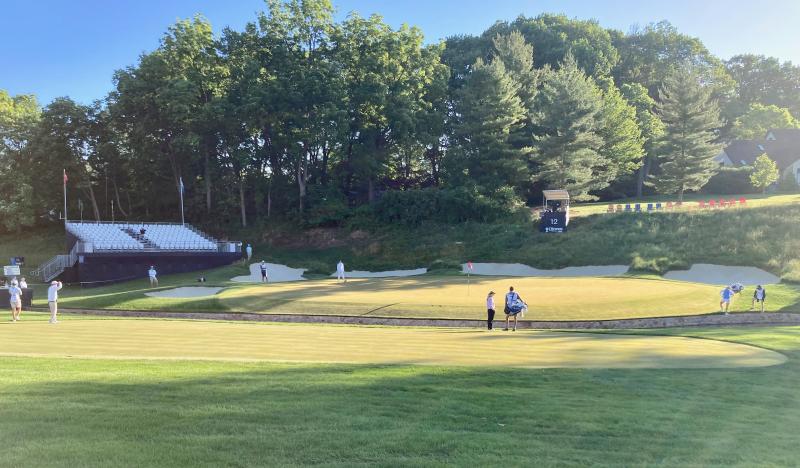NASCAR comes to the U.S. Women’s Open – the par threes at Lancaster CC
The four par three holes on the par 71 Flynn Course at Lancaster Country Club are beautiful but dangerous.
Each uses similar yardages off the tees. Their other characteristics remain unique.
Golf architect William Flynn took advantage of the rolling terrain, using varying elevations, and greenside hazards and shapes to bedevil golfers.
In the best example from this year’s U.S. Women’s Open, LPGA star Nelly Korda posted a 10 on the par three 12th hole during the first round. That blowup led to a rare missed cut.
As the tournament continued, I knew all four par threes would attract NASCAR fans to golf.
Those folks are famous for loving the chance to see amazing crashes, along with the display of some great skills by those who don’t.
So, for all you crash fans, this is the first of a series about Lancaster’s short holes, and the triumphs and tragedies displayed there during the Women’s Open.
The series begins with the 12th hole, if only because of Korda’s 10.
The tee box at 163 yards sits about 40 feet above the green, with a steep upslope beyond it. Five bunkers ring the left, back and right sides.
A steeply walled creek lies a very short distance from the green’s front. The creek is dammed a short distance past the hole, widening it significantly compared to the rest of its stream bed.
Think of the Swilcan Burn on St. Andrews’ first and 18th holes.
The green is only 21 yards deep. For the first round, the hole was set six yards from the front edge. With its false-front design, however, those six yards were more like three.
Korda’s 10 began with a mistaken club selection. She used a six-iron in the swirling wind when a seven-iron would have worked.
Her ball landed on a leaf in a back bunker. Korda’s second shot rolled across the green and down its false front into the creek. She tried a low skipper from the fairway level turf across the creek, but it checked up, stopped and rolled back into the water. Korda tried the same method again with the same result. A stronger chip on her eighth shot stopped nearly 9 feet above the hole, and her first putt went 3 feet too far. She made the next putt for the shocking 10, the news of which ran through the 427-acre property like blazes.
Korda’s troubles were by no means the only ones players found that day on the 12th.
Delays were common. Balls in the water or other issues forced the officials to start waving up the next group to tee off before the group in front finished the hole. I timed one player taking 20 minutes to take the first putt after her tee shot because of the wave-up and waits.
Individual problems far outweighed the logistical, however.
I watched 2023 U.S. Women’s Open winner Allisen Corpuz land her tee shot in the back fringe, where she tried to chip it from about 50 feet. The ball rolled slowly and inexorably into the creek. Her next shot, from the creek’s other side, stopped about 5 feet past. The next putt rolled 4 feet too far, leading to an eventual triple bogey.
Yealimi Noh dumped her tee shot directly into the creek, about 30 feet short of the hole. After a penalty drop near the creek edge, she hit a low skipper into the false front, thinking it would check up and stop close to the hole. Didn’t work – rolled back into the creek.
Another drop, another low skipper, but this time with some oomph behind it. The ball stopped 3 feet above, and Noh one-putted for her six.
Amateur Megan Schofill surprised the crowd when her tee shot landed short of the hole and stayed there, instead of rolling backward into the creek. Her first putt from 10 feet below stopped a foot away for a nice par.
Multiple major winner Anna Nordqvist showed how it’s done from the back fringe, 45 feet from the hole. Her putt from there went about a foot past, with a simple putt uphill for her par.
Miyu Yamashita is only 22 but has already won 11 times on the Japan LPGA. She made some new fans at Lancaster when her putt from 31 feet right and above the hole finished 4 inches away for a tap-in par.
Huge anticipatory roar and then the inevitable “awww.”
At day’s end, the 12th hole finished as the hardest hole in the first round, with a nasty 3.801 average. The scores included 32 double bogeys and 13 triples or worse. The next-hardest hole that day was the par three eighth at “only” 3.468.
Even so, the 12th wasn’t bad for everyone. Just after I left it, Sweden’s Madeline Sagstrom rolled in a 21-footer from above the hole for a birdie, causing a remarkably loud cheer from those who saw it.
I think their reaction had something to do with pent-up emotion – kind of like NASCAR fans.
























































